Open Journal of Business and Management, 2019, 7, 963-975
http://www.scirp.org/journal/ojbm
ISSN Online: 2329-3292
ISSN Print: 2329-3284
Risk Measurement of Chinese Stock Market
Based on GARCH Model and Extreme
Value Theory
Shixue Du*, Guoqiang Tang, Shijun Li
School of Science, Guilin University of Technology, Guilin, China
How to cite this paper: Du, S.X., Tang,
G.Q. and Li, S.J. (2019) Risk Measurement
of Chinese Stock Market Based on GARCH
Model and Extreme Value Theory. Open
Journal of Business and Management, 7,
963-975.
https://doi.org/10.4236/ojbm.2019.72065
Received: March 26, 2019
Accepted: April 22, 2019
Published: April 25, 2019
Copyright © 2019 by author(s) and
Scientific Research Publishing Inc.
This work is licensed under the Creative
Commons Attribution International
License (CC BY 4.0).
http://creativecommons.org/licenses/by/4.0/
Open Access
Abstract
The risk of the stock market has always been a hot issue for investors. This
paper selects the daily closing price data of the Shanghai and Shenzhen 300
Index of the Shanghai stock exchange, the Shenzhen 300 Index of Shenzhen
stock exchange, the Hang Seng Index of the Hong Kong stock exchange mar-
ket and Taiwan Weighted Index of the Taiwan stock market and calculates
logarithm and difference. The GARCH model is combined with the POT
model of extreme value theory to measure the risk. Comparing the failure
rates at the three significance levels of 0.05, 0.025 and 0.01, the failure rates
are close to the level of significance, which conduct that the GARCH-POT
model can measure the risk of Chinese stock market well.
Keywords
GARCH Model, Extreme Value Theory, VaR
1. Introduction
The risk of the stock market has been always widely concerned by researchers
and investors. In the past three decades, financial market volatility has become
obvious because of economic globalization and financial innovation, which makes
financial risk management a necessary tool and capability for business enterprises
and financial institutions to operate and manage. Value at Risk (VaR) is a widely
used method of measuring financial risk. Domestic and foreign scholars have
made fruitful research on the risk measurement of the stock market.
Domestic and foreign scholars have done a lot of research on the measurement
of risk value. The most traditional VaR model is based on the premise that the
hypothesis rate of return follows the normal distribution, while the financial time
DOI: 10.4236/ojbm.2019.72065 Apr. 25, 2019
963
Open Journal of Business and Management
�
S. X. Du et al.
DOI: 10.4236/ojbm.2019.72065
series often has volatility clustering and non-normality [1]. In order to better solve
the non-normality and volatility aggregation of financial time series, Engle (1982)
first proposed an autoregressive conditional heteroskedastic (ARCH) model,
which is considered to be a function of past error. The ARCH model is a good
indicator of the fluctuating agglomeration of financial markets [2]. On the basis of
the ARCH model, Bollerslev (1986) extended it to the generalized autoregressive
conditional heteroskedasticity (GARCH) model, and considered that the condi-
tional variance is not only a function of the past error, but also a function of the
conditional variance of the lag. The GARCH model not only reveals the “fluc-
tuating agglomeration” characteristics of financial markets, but also reflects the
“thick tail” characteristics. Therefore, the GARCH model can be used to charac-
terize financial time series that are thicker than the tail of a normal distribution [3].
Later, in order to reveal the asymmetry and leverage effect of financial data,
Nelson (1991) proposed an index GARCH (EGARCH) model, which introduces
parameters γ in the conditional variance equation to distinguish between posi-
tive and negative external impacts on the price of financial products. Since then,
the GARCH family model has continued to grow and develop, such as: TGARCH
model, IGARCH model, GJRGARCH model [4]. Gong Rui (2005) compared the
GARCH model, EGARCH model and PARCH model of the Shanghai Composite
Index, Shanghai Stock Exchange 180 Index and Shenzhen Composite Index under
the normal distribution, t distribution and GED distribution, and calculated the
corresponding VaR values. It is considered that the VaR value under the t dis-
tribution is too conservative, and the GED distribution is more accurate to de-
scribe the characteristics of the yield [5]. Dong ran (2016) measured the risks in
the national debt market, believed that the Shanghai municipal government bond
index had leverage effect, and suggested investors to accurately judge the market
information before investing [6].
Extreme events are small probability events, once happen these small probability
events can cause huge losses. Extreme Value Theory (EVT) is a theory for mod-
eling and analyzing tail data. It is widely used in many fields such as technology
engineering, environment, and geological disasters. The two models commonly
used in extreme value theory are BMM model and POT model. The BMM model
first divides the financial time series into several sub-intervals according to a
certain standard, models the maximum (minimum) value of each set of data, and
obtains the parameter estimation according to the maximum likelihood estima-
tion or other estimation methods. However, the traditional BMM model relies on
the choice of the length of the subinterval, and it is easy to ignore some valuable
data. At present, the most widely used is the POT model, which can make full use
of limited observations. The POT model models all observations that exceed a
given threshold, which approximates the Generalized Pareto Distribution. There
are many methods for selecting the threshold, such as Hill estimation method,
kurtosis method, and over-expectation function graph method. These methods
have their own advantages and disadvantages, and there is no unified selection
964
Open Journal of Business and Management
�
S. X. Du et al.
standard. Mcneil (2000) combined the GARCH family model with extreme value
theory for the first time and constructed the GARCH-EVT model to predict the
VaR of financial products [7]. Tang Yong (2012) used the kernel fitting goodness
statistical method and the average excess distribution function graph to select the
threshold respectively, and fitted the POT model to the low-frequency data and
high-frequency data distribution, and considered that the kernel fitting goodness
statistical method was more effective to select the threshold comparison [8].
Zhang Hu (2016) used the extreme value theory to study the risk value of the
return rate of stock market [9]. Wang Miao (2017) used extreme value theory to
study the fluctuation of the Shanghai stock market and the conditional risk value
(CVaR) of the characteristic of thick tail [10].
With the integration of international finance, every stock market is not an in-
dependent entity. Due to the increasing economic ties around the world, the stock
market in Hong Kong and Taiwan have a longer history than the mainland. At
present, there are relatively few literatures on the risk measurement of these four
stock markets in China. This paper selects the daily closing price data of Shanghai
and Shenzhen 300 Index of Shanghai stock exchange, the Shenzhen 300 Index of
Shenzhen stock exchange, the Hang Seng Index of Hong Kong stock exchange
market and the Taiwan Weighted Index of Taiwan stock exchange market, and
combines the GARCH model with the POT model of extreme value theory to
measure risk.
2. Empirical Methodology
2.1. VaR
Value at Risk (VaR) is the maximum possible loss of a particular financial asset
for a given period of time m at a certain level of confidence 1 p− . Define it as
follow:
VaR
− =
p
1
inf
{
( )
x F x
|
m
1
≥ −
}
p
(1)
where the inf indicates the minimum value that satisfies the real number x in the
condition. As you can see from the definition,
≤
)
F VaR
m
p
1
−
L m VaR
1
≥ −
t
1
−
1
≥ − , that is:
p
(2)
Pr
p
(
)
(
p
(
)
tL m represents the loss random variable of the position of the financial
where
asset. Therefore, from time t to time t m+ , the probability that the potential loss
of the gold financial position holder is less than or equal to
is 1 p− .
VaR −
1 p
2.2. GARCH Model
Common one-dimensional volatility models include ARCH models, GARCH
models, and EGARCH models. In general, the return on financial assets has the
characteristics of “volatility aggregation”, that is, the volatility is high in a certain
period of time, and the volatility is small in other time periods. (p, q) in the
GARCH (p, q) model represents the ARCH coefficient p and the GARCH term
965
Open Journal of Business and Management
DOI: 10.4236/ojbm.2019.72065
�
S. X. Du et al.
t
a
t
tr , Define
r µ= −
t
ta GARCH(p,q) model if
coefficient q. The model consists of two equations: one is the conditional mean
equation and the other is the conditional variance equation. For logarithmic rate
of return
as the disturbance or new interest at time t. We
ta satisfies the following formula:
call
r
=
t
=
a
t
2
a
σ α α
=
t
i
−
µ
+
t
σε
t
2
βσ
t
−
(3)
∑
∑
a
t
+
+
1
=
1
=
p
q
0
t
t
i
j
j
i
j
where { }tε is independent and identically distributed random variable sequence
with mean 0 and variance of 1.
jβ ≥ ,
. For
0
p>
i
iα = ; for j
jβ = . The last constraint for
0
ta is limited. At the same
iα β+
tσ is time-varying. This article uses a low-order
time, its conditional variance
GARCH (1, 1) model:
, it must be
guarantees that the unconditional variance of
iα > ,
0
0
q> , it must be
(
α β
i
0α > ,
(
∑
max
+
<
0
p q
,
1
)
1
=
2
)
i
i
i
a
t
r
µ
=
+
t
t
=
a
σε
t
t
2
2
a
σ α α
βσ−
=
+
t
t
1
1
1
−
+
0
1
t
t
(4)
2.3. POT Model
The full name of the POT model is the peak beyond the threshold, independent of
the choice of the length of the subinterval, but requires a threshold. For a fixed
shape parameter ξ, the mean excess function is a linear function of
. De-
fine the empirical mean excess function as:
u u−
0
( )
e u
T
=
N
1
u
−∑
N =
iu
1
x
t
i
(
)
u
(5)
uN is the number of exceeding the threshold u, named the excess;
itx is
where
the value corresponding to the rate of return. The criterion for selecting a thre-
shold by exceeding the excess function is that selecting a threshold that is large
enough, and the mean excess plot after the threshold is approximately linear.
Suppose the log-return is 1
x
i
pressed as:
= − is the number of excess. The distribution function of the excess is ex-
r , the distribution function is
( )F r ,
r r
2,
, n
u
r
i
,
( )
F x
u
=
Pr
(
r u r
|
−
>
u
)
=
(
F x u
+
1
−
( )
)
F u
−
( )
F u
,
x
≥
0
(6)
Transform Equation (6) to get:
( )
F r
=
(
F x u
+
)
=
−
1
( )
( )
F u F x
u
+
( )
F u r
,
>
u
(7)
For a sufficiently large threshold u,
uF x can be approximately expressed as
Generalized Pareto Distribution (GPD). GPD distribution includes shape para-
G x ξβ can be de-
meters ξ and scale parameters β. GPD distribution
(
)
;
,
( )
DOI: 10.4236/ojbm.2019.72065
966
Open Journal of Business and Management
�
scribed as:
(
)
G x
;
ξβ
,
(
− +
1
1
=
1 exp
−
1
−
)
x
ξ β
(
)
−
β
x
S. X. Du et al.
ξ
≠
ξ
=
ξ
0
0
(8)
For the distribution function
pirical estimate (
)u
actual sample as follows:
n N
−
n
( )F r , it can be approximately expressed as em-
. Then you can get the distribution function of the
( )
F r
1
= −
uN
n
+
1
ξ
(
β
r u
−
−
1
ξ
)
,
r
>
u
(9)
3. Empirical Study
3.1. Data Description
This paper selects the daily closing price data of the Shanghai and Shenzhen 300
Index of the Shanghai stock exchange, the Shenzhen 300 Index of Shenzhen stock
exchange, the Hang Seng Index of the Hong Kong stock exchange market and
Taiwan Weighted Index of the Taiwan stock market. The time period is from
March 7th, 2014 to March 7, 2019. The trading hours of stock markets in mainland
China, Hong Kong and Taiwan are not completely consistent. In order to main-
tain the consistency of data, the data processing method of Pei Yanhua et al. [11]
(2017) is adopted to eliminate data with inconsistent transaction dates to get 1158
data. The logarithm and a difference operation of the daily closing price sequence
is performed to obtain a daily logarithmic rate of return sequence, for a total of
1157 data. The article data comes from the CSMAR database, and the analysis of
this article is implemented by R software.
It can be seen from Table 1 that the daily logarithmic yield series of the Shanghai
and Shenzhen 300 Index, the Shenzhen 300 Index, the Hang Seng Index and the
Taiwan Weighted Index are all left-biased as the skewness is less than 0, and the
kurtosis is significantly greater than 3, both with sharp peaks and thick tails feature.
The J-B statistic rejects the null hypothesis of the normal distribution. It can also
be seen from Figure 1 that the four indices are not obey to normal distribution
as the scatter is away from the line. Both the ADF test and the P-P test passed,
indicating that the yields of the four indices were stable. The volatility clustering
feature refers to the fact that the volatility is high in a specific period of time
while it is low in other periods. It can be seen from the daily logarithmic rate of
return timing chart in Figure 2 that all four index yields exhibit volatility ag-
gregation characteristics. The ARCH effect test is performed on the four yield
series, and the results show that the rate of return series has conditional hete-
roscedasticity.
3.2. GARCH Model Establishment
According to the above analysis, the Shanghai and Shenzhen 300 Index, the
Shenzhen 300 Index, the Hang Seng Index and the Taiwan Weighted Index are
967
Open Journal of Business and Management
DOI: 10.4236/ojbm.2019.72065
�
S. X. Du et al.
Table 1. Descriptive statistics of log-returns.
Sample size
Minimum
Maximum
Mean
Stdev
Skewness
Kurtosis
J-B
ADF
P-P
ARCH-LM
HS300
1157
−0.091544
0.077524
0.000489
0.016196
−0.811693
6.594329
2234.2971
−10.095
−33.121
197.25
SZ300
1157
0.000310
0.098733
0.000310
0.017878
−0.785064
5.326195
1494.1584
−10.376
−32.322
241.38
HSI
1157
TWII
1157
−0.060183
−0.065206
0.069870
0.000212
0.011238
−0.248895
3.758039
697.0613
−10.545
−33.393
36.617
0.035175
0.000145
0.008668
−0.919614
6.500682
2211.0504
−10.756
−33.899
89.327
Figure 1. QQ plot of daily log-returns.
DOI: 10.4236/ojbm.2019.72065
Figure 2. Time series of daily log-returns.
968
Open Journal of Business and Management
�
S. X. Du et al.
all stationary sequences, and all have an ARCH effect. The GARCH model not
only reveals the “fluctuating aggregation” of financial markets, but also reveals the
“thick tail” feature. According to previous scholars' research, the low-order
GARCH (1, 1) model can well describe the characteristics of financial time series.
Therefore, this paper establishes a low-order GARCH (1, 1) model for the
Shanghai and Shenzhen 300 Index, the Shenzhen 300 Index, the Hang Seng Index
and the Taiwan Weighted Index.
Table 2 is the parameter estimation results of the GARCH (1, 1) model, except
for the constant term, all the parameters pass the significance test. Among them,
the ARCH parameter αand the GARCH parameter β are both greater than
zero, which guarantees the positive definiteness of the conditional variance, and
also indicates that fluctuations of the stock market are characterized by agglo-
meration. The historical fluctuations are positively correlated with the current
fluctuations and the speed is gradually slowed down. The large fluctuations often
follow with large fluctuations, investors are more speculative in the stock market.
α β+
A white noise test is performed on the standardized residual of the model, and
the test statistic is the LB statistic. The results are shown in Table 3. Under the 6th
and 12th order lags, the P value of the LB statistic is significantly greater than 0.05.
It can be considered that the residual of the model belongs to the white noise
sequence, that is, the model can well characterize the log yield series.
1
< ensure that the model is a smooth GARCH model.
3.3. POT Model Establishment
An estimate of the standard deviation can be obtained from the above GARCH (1,
1) model. Since the GARCH (1, 1) model measures the risks in the normal market,
in reality, there are often a few extreme values that can cause huge losses.
Therefore, here we establish a GARCH (1, 1)-POT model for the normalized re-
sidual of the GARCH (1, 1) model, that is, model the super-threshold data ex-
ceeding the threshold u. The most important thing to establish a POT model is the
choice of threshold. If the threshold is too large, the sample data exceeding
Table 2. Parameter estimation of GARCH (1, 1) model.
µ
ω
α
β
HS300
0.000683
0.000001
0.073318
0.925682
SZ300
0.000469
0.000002
0.051851
0.943504
HSI
0.000570
0.000002
0.049425
0.935894
TWII
0.000359
0.000006
0.106299
0.816171
Table 3. White noise test of residual.
HS300
SZ300
HSI
TWII
P value
Lag = 6
0.6919
Lag = 6
0.7399
Lag = 6
0.9241
Lag = 6
0.7382
Lag = 12
0.3987
Lag = 12
0.9446
Lag = 12
0.8979
Lag = 12
0.7359
969
Open Journal of Business and Management
DOI: 10.4236/ojbm.2019.72065
�
S. X. Du et al.
DOI: 10.4236/ojbm.2019.72065
the threshold will be too small, which may increase the variance of the parameter
estimation. If the threshold is too small, the excess cannot be guaranteed to obey
the generalized pareto distribution, which may result in biased parameter esti-
mates. The method of selecting the threshold generally adopts the method of
transcending the expectation function, and the selected threshold which value
exceeds the threshold part to present a linear characteristic. In addition, there is
the 10% principle proposed by Du Mouchel [12]: when the threshold u is allowed,
about 10% of the data is selected as the extreme value data to be studied.
According to the graph of the transcendental expectation function of Figure 3,
based on the 10% principle proposed by Du Mouchel, it can be seen that the mean
excess plot shows a linear trend after 1.1 or 1.2. Therefore, the thresholds are se-
lected to be 1.2, 1.2, 1.2 and 1.1 respectively. The generalized Pareto distribution
(GPD) is fitted to the data exceeding the threshold, and the estimation results of
the shape parameters and the scale parameters are shown in Table 4.
In order to test the fitting effect of the model, the diagnostic test charts of the
GARCH (1, 1)-POT models of the standardized residuals of the four index yield
series are shown in Figures 4-7 respectively. The upper left corner is the distri-
bution function graph of the overrun, the upper right corner is the distribution tail
probability estimation graph, the lower left corner is the residual scatter plot, and
the lower right corner is the residual QQ plot. The closer the scatter and the line are,
the better the model fits. It can be seen from the four graphs that most of the scatter
points are on or near the line, and very few points have slight deviations
Figure 3. Mean excess plot.
Table 4. Model parameter estimation of GARCH (1,1)-POT model.
Threshold
Excess
ξ
β
HS300
1.2
117
SZ300
1.2
100
HSI
1.2
110
TWII
1.1
108
−0.009138573
−0.008040062
0.583801381
0.498632659
0.05280263
0.48535986
−0.04282757
0.53193409
970
Open Journal of Business and Management
�
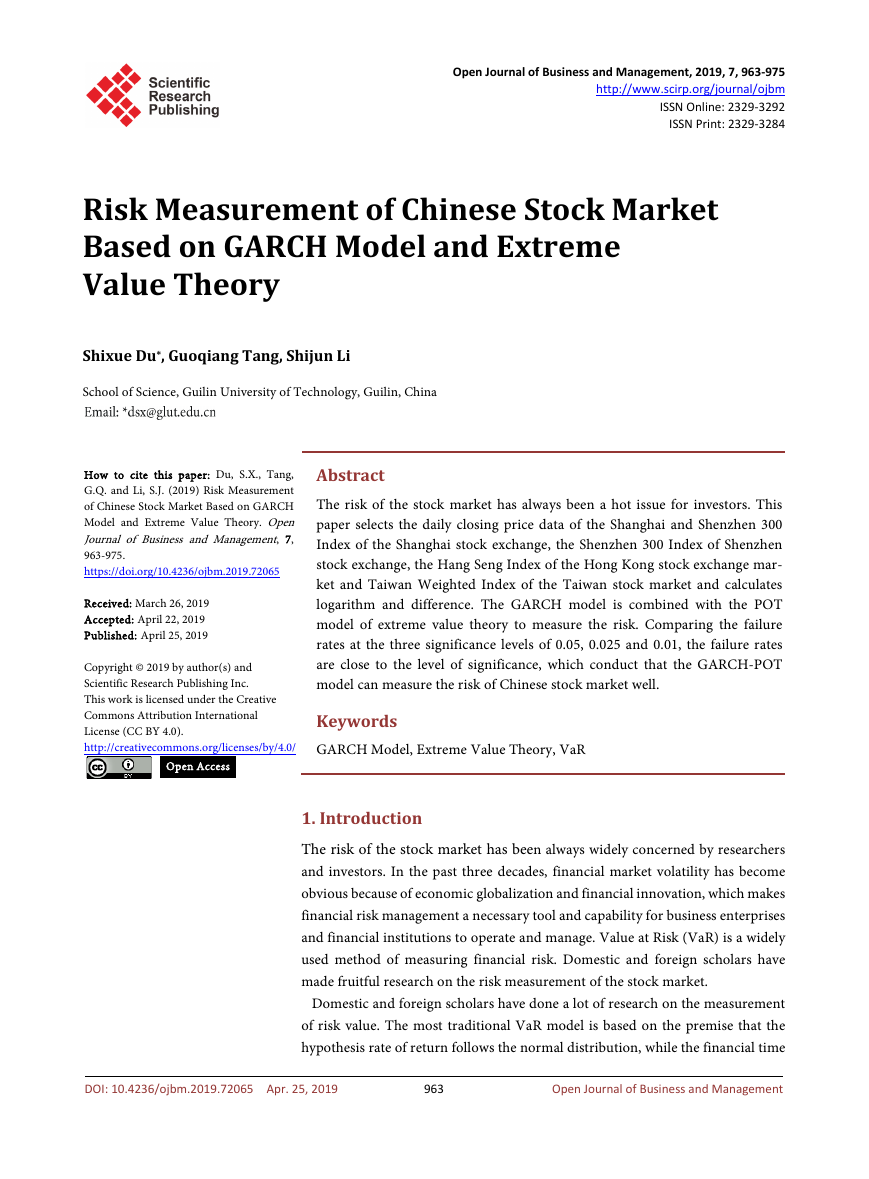
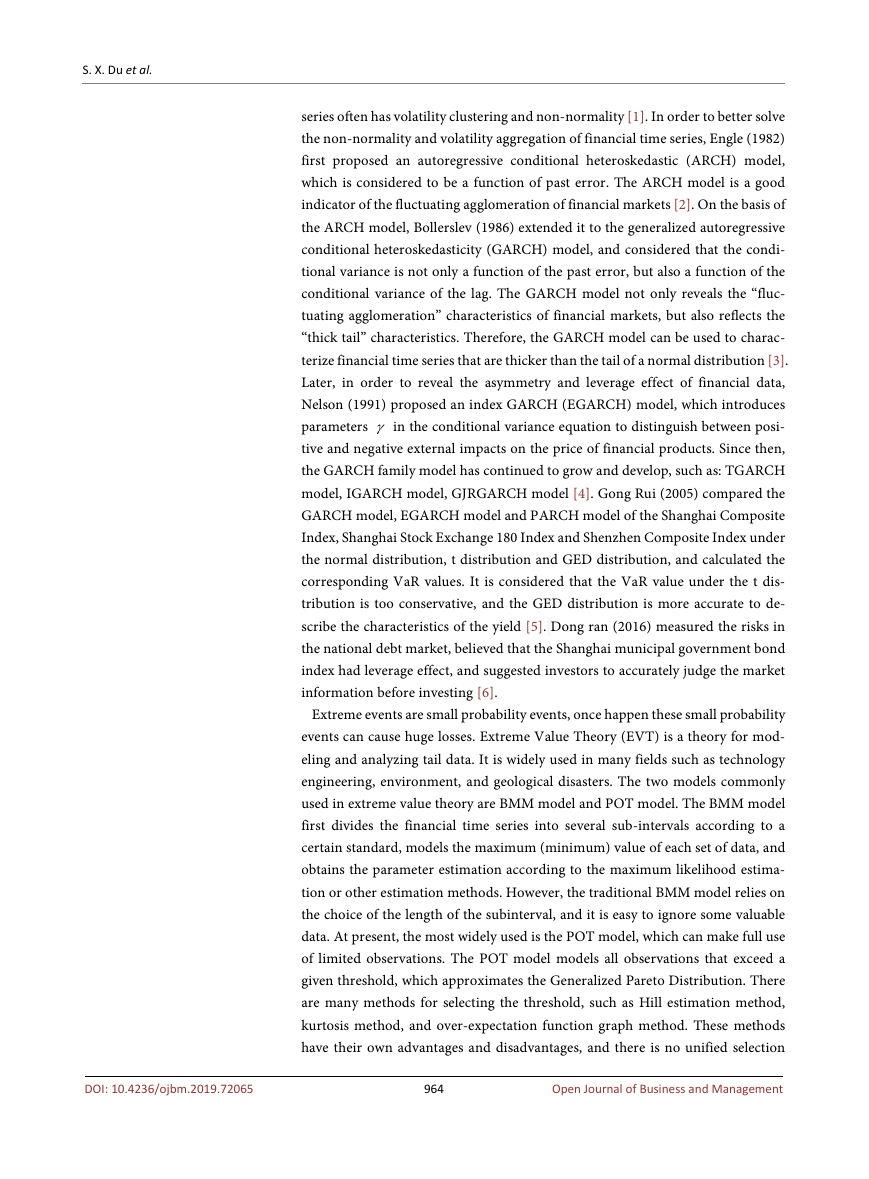
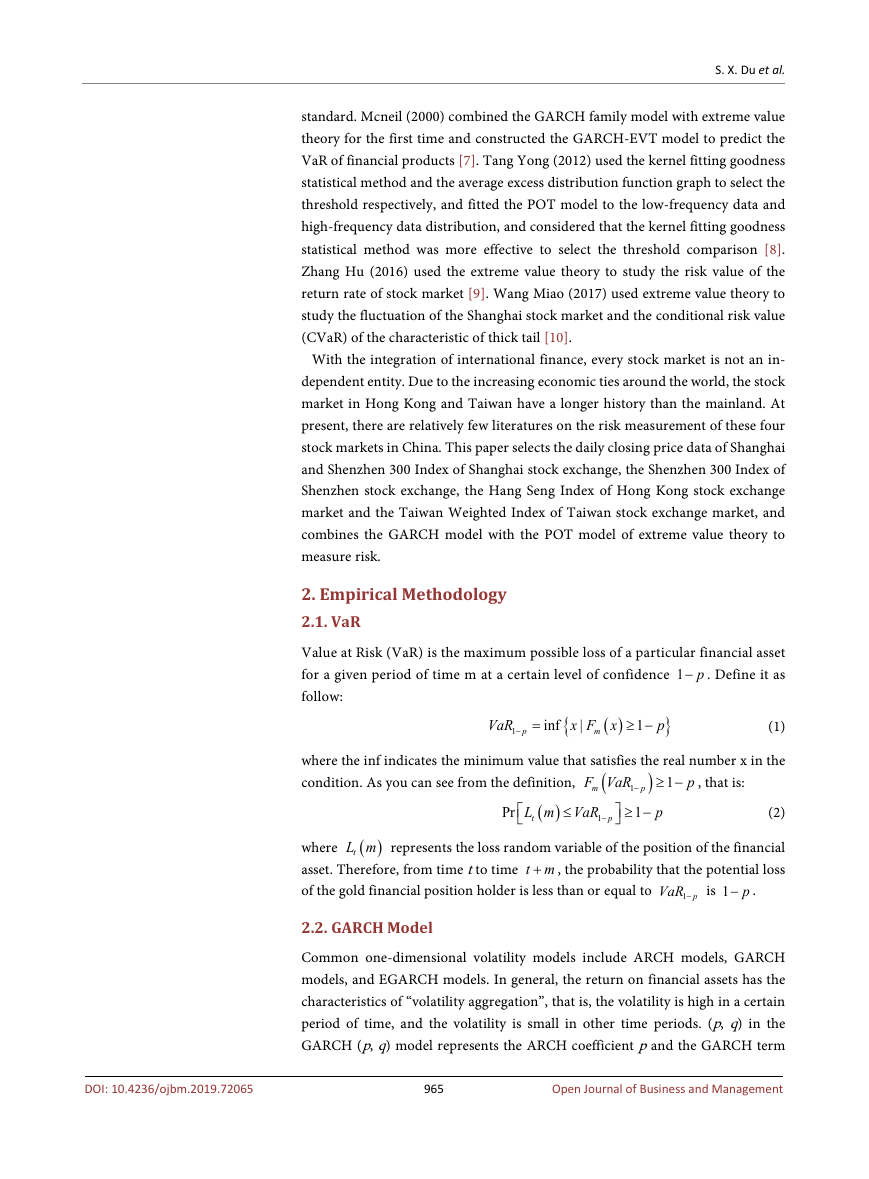


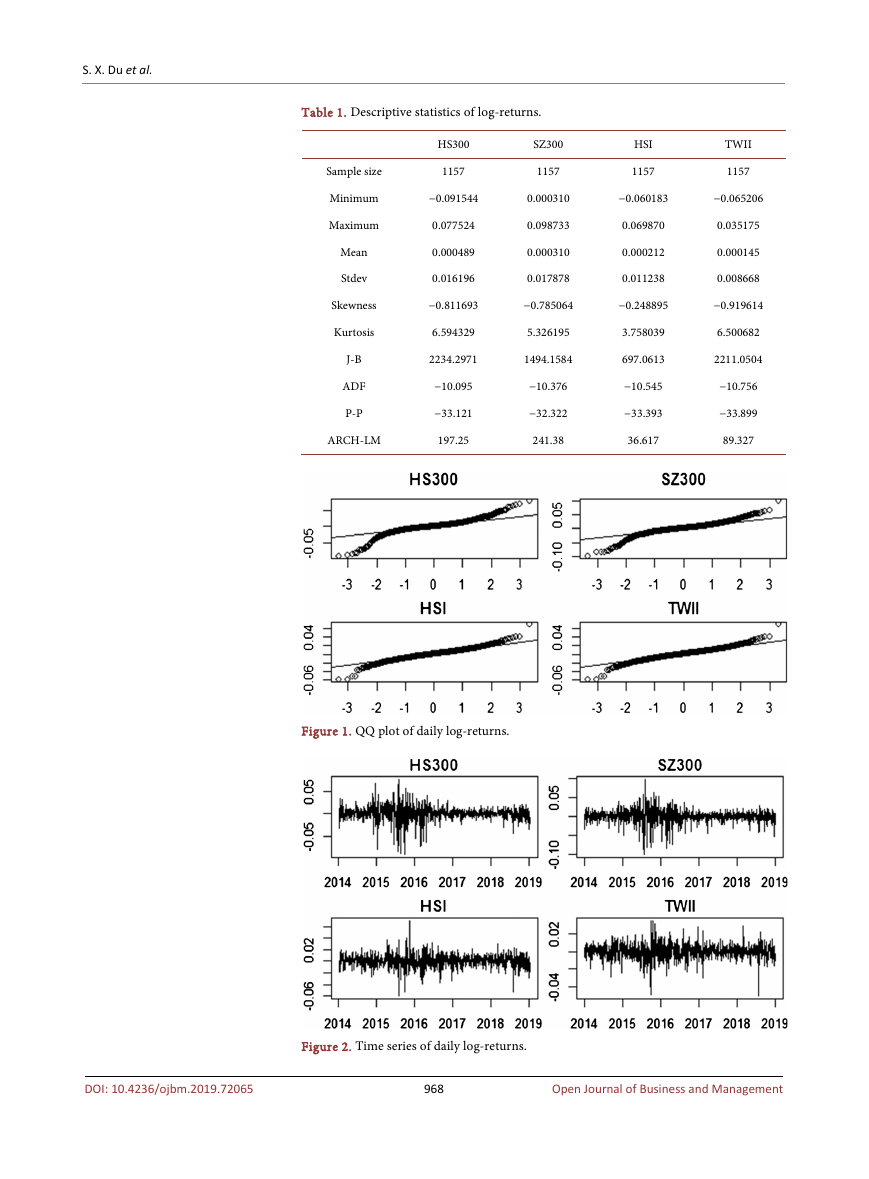

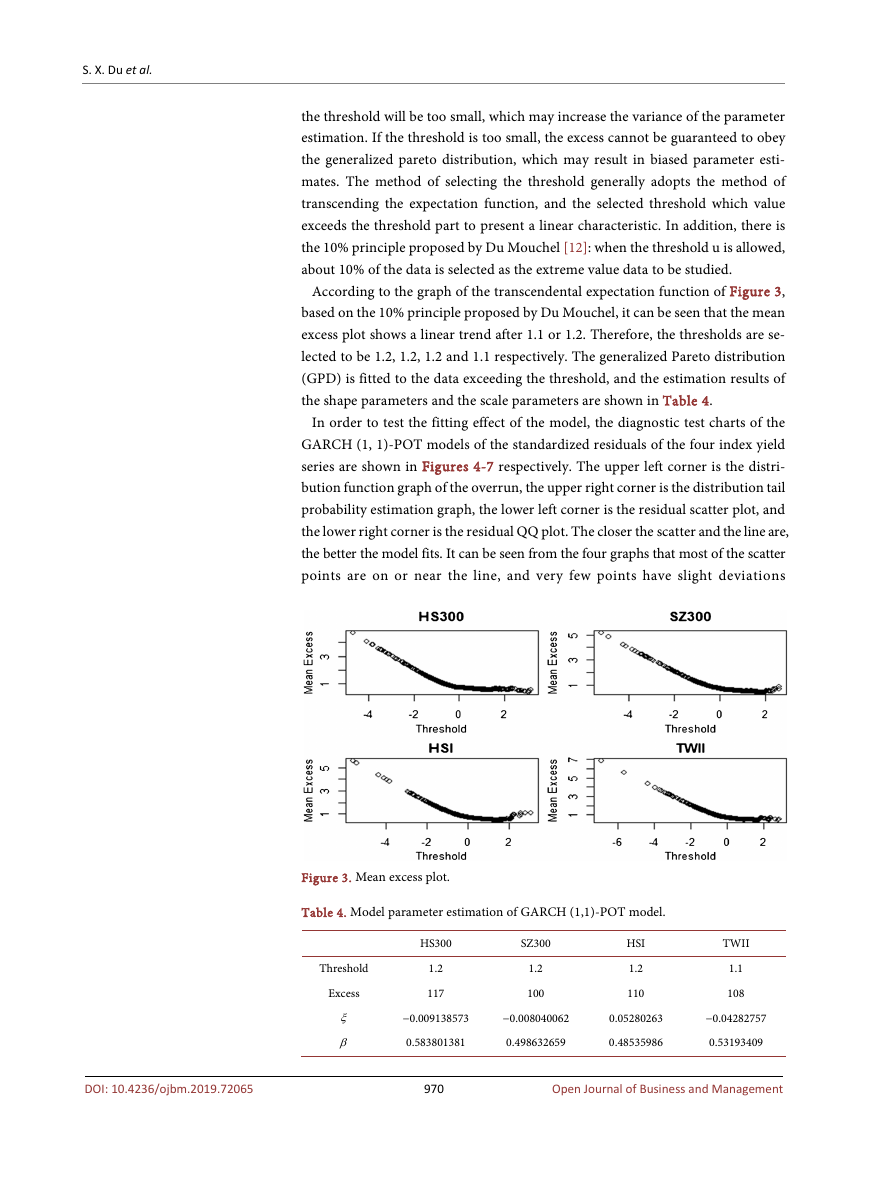








 2023年江西萍乡中考道德与法治真题及答案.doc
2023年江西萍乡中考道德与法治真题及答案.doc 2012年重庆南川中考生物真题及答案.doc
2012年重庆南川中考生物真题及答案.doc 2013年江西师范大学地理学综合及文艺理论基础考研真题.doc
2013年江西师范大学地理学综合及文艺理论基础考研真题.doc 2020年四川甘孜小升初语文真题及答案I卷.doc
2020年四川甘孜小升初语文真题及答案I卷.doc 2020年注册岩土工程师专业基础考试真题及答案.doc
2020年注册岩土工程师专业基础考试真题及答案.doc 2023-2024学年福建省厦门市九年级上学期数学月考试题及答案.doc
2023-2024学年福建省厦门市九年级上学期数学月考试题及答案.doc 2021-2022学年辽宁省沈阳市大东区九年级上学期语文期末试题及答案.doc
2021-2022学年辽宁省沈阳市大东区九年级上学期语文期末试题及答案.doc 2022-2023学年北京东城区初三第一学期物理期末试卷及答案.doc
2022-2023学年北京东城区初三第一学期物理期末试卷及答案.doc 2018上半年江西教师资格初中地理学科知识与教学能力真题及答案.doc
2018上半年江西教师资格初中地理学科知识与教学能力真题及答案.doc 2012年河北国家公务员申论考试真题及答案-省级.doc
2012年河北国家公务员申论考试真题及答案-省级.doc 2020-2021学年江苏省扬州市江都区邵樊片九年级上学期数学第一次质量检测试题及答案.doc
2020-2021学年江苏省扬州市江都区邵樊片九年级上学期数学第一次质量检测试题及答案.doc 2022下半年黑龙江教师资格证中学综合素质真题及答案.doc
2022下半年黑龙江教师资格证中学综合素质真题及答案.doc